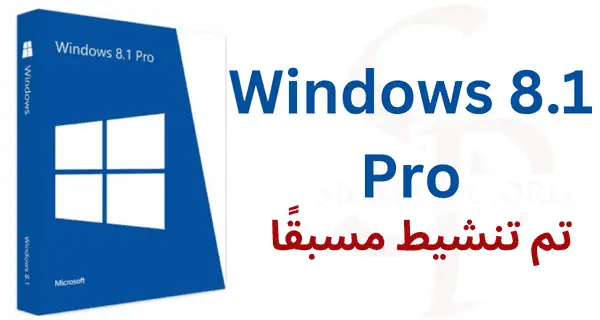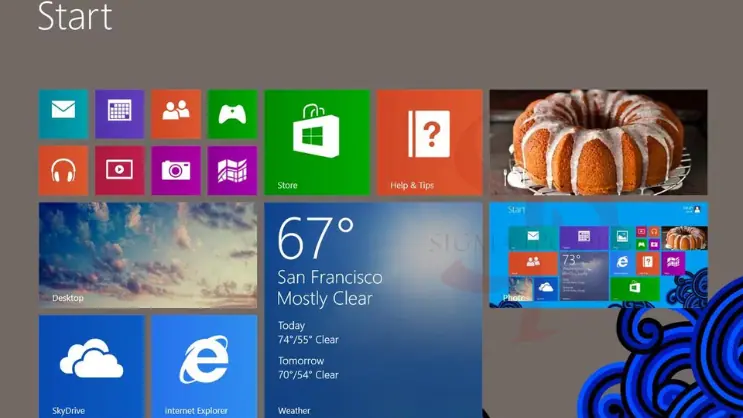Windows 8.1 Pro is pre-activated.

Download Windows 8.1 Professional Activated for Life is an updated version of Windows 8, released by Microsoft in October 2013.
It features a Metro interface with simplified buttons and apps that are easy to use on touch screens. This update has improved system performance and responsiveness, making it faster than Windows 8.
Windows 8.1 includes a customizable Start screen with live tiles. It also retains the traditional desktop for users who prefer a classic interface.
The 64-bit version integrates with OneDrive, allowing for cloud storage and access from anywhere. Despite some criticism of its interface, Windows 8.1 is known for its improvements and features.
Information about downloading the original Windows 8.1 Pro “ISO” copy on a flash drive
Download Windows 8.1 from Mediafire is an update to Windows 8, released by Microsoft in October 2013. Initially available as a free upgrade for existing users, it is now also available for purchase as a full version.
Windows 8.1 introduced the Metro user interface, designed for touchscreens and tablets, featuring live tiles. Released in response to feedback, it brought major improvements such as direct access to the desktop, an improved Windows Store, and better integration with Microsoft's cloud services.
With improved performance and stability, Windows 8.1 has become popular among users. Now you can download the latest version with lifetime activation key.
Features of downloading compressed Windows 8.1 from Mediafire
Windows 8.1 with activation crack free download offers many improvements over Windows 8. Notable features include:
- Improved Start Button: The traditional Start button is back, providing direct access to the Start screen.
- Customizable Start Screen: Users can customize the Start Screen with live tiles, resize them, and organize them.
- Return of the Start menu on the desktop: Set the classic desktop as the default, making it similar to Windows 7.
- Improved built-in apps: Enhanced apps like Internet Explorer, Mail, Calendar, and Gallery.
- Cloud integration: Improved integration with OneDrive for easy access to files online.
- Better Performance: Smoother, faster performance with increased stability.
- Device Compatibility: Works across Android PCs, tablets, and laptops.
These features make Windows 8.1 a popular choice for operating system users.
How to Download and Install Windows 8 from Microsoft ISO on Your Device Easily
You can download and install Windows 8.1 using one of the following methods:
- Download ISO: Find a trusted site that offers the Windows 8.1 for low-end 64-bit ISO file. It can be downloaded from Microsoft or another trusted source.
- Create Installation Media: After downloading the ISO or using the original installation media, use tools like Rufus or Microsoft's USB/DVD tool to create bootable installation media. Connect it to your computer, restart it, and begin the installation.
- Install from the Microsoft Store: If you have a digital edition, you can install Windows 8.1 directly from the Microsoft Store. Search for “Windows 8.1 Version 2024,” then download and install it.
Follow the installation instructions:
- I accept the license terms.
- Select language, time and region.
- Enter your product key, or it may recognize it automatically if you have a digital copy.
- Specify the installation location and partition settings.
After installation, Windows 8.1 will be ready to use, activated, and support Microsoft Office 365 .
How to install Windows 8.1 from hard disk final version 2024 for free
Here's how to install Windows 8 with lifetime activation directly from your hard drive if you have an ISO file:
- Download the Windows 8 ISO file: Get the Windows 8 ISO file from a trusted source, such as the Microsoft website. Use software like Rufus to burn the ISO file to a hard drive or USB flash drive.
- Prepare your computer: Connect the hard drive or USB containing the ISO file to your computer. Restart, then enter BIOS/UEFI to set the system to boot from the hard drive or USB.
- Start the Windows 8 installation: Once the system boots up, the installation screen will appear. Choose your language, time, and keyboard preferences, and then click Next.
- Install Now: Click Install Now to begin. If prompted, enter your product key and click Next.
- Accept the license terms: Review and accept the license terms. Then select “Custom: Install Windows only (Advanced)” to manage partitions.
- Select partition: Select the partition you want to install Windows on. Format if necessary, then click Next to begin the installation.
- Complete the installation and setup: Once the installation is complete, you will be asked to configure basic settings (language, region, and user account). After that, your Windows 8 (x86/x64) with lifetime activation will be ready to use.
Before proceeding, back up all important files, and follow each step carefully for a smooth installation.
Genuine Windows 8.1 32-bit OS Requirements
Here are the system requirements to install Windows 8.1:
- Processor (CPU): 1 GHz or faster.
- Memory (RAM): 1 GB or more.
- Hard disk storage space: 16 GB of free space.
- Graphics Card (GPU): DirectX 9 graphics device with WDDM 1.0 or higher driver.
- Screen: Minimum resolution 800 x 600 pixels.
- Audio: Windows compatible audio device.
- Optical drive (optional): DVD-ROM drive if you are installing from DVD media.
Make sure your device meets these specifications for optimal performance.
Windows 8.1 64-bit Operating System Requirements
- Processor (CPU): 1 GHz or faster, 64-bit architecture.
- Memory (RAM): 2 GB or more.
- Storage Space: At least 20 GB of free space.
- Graphics Card (GPU): DirectX 9 graphics device with WDDM 1.0 or higher driver.
- Screen: Minimum resolution 800 x 600 pixels.
- Audio: Built-in Windows compatible audio.
- Optical Drive (Optional): DVD-ROM drive for installation from DVD media.

Frequently Asked Questions
Is it safe to download Windows 8.1 Download ISO to a flash drive?
To safely download and use the Windows 8 ISO file on a USB flash drive, follow these steps:
- Verify the source: Only download the ISO file from official sources like Microsoft website.
- Checksum Validation: Verify the downloaded file using a checksum to ensure that nothing has been changed.
- Burn ISO file: Use a trusted software like Rufus or Windows USB/DVD Download Tool to create a bootable USB drive.
- Back up your data: Save any important files from the USB drive before creating the installation media, as they will be erased.
- System updates: After installation, keep your system up to date with the latest security patches.
Avoid downloading from untrusted sites like Mediafire to stay safe.
Is your PC ready for Windows 8.1 Pro?
To determine if your PC is ready for the Windows 8.1 Pro desktop, follow these instructions:
- Check system requirements: Make sure your computer meets the minimum processor, RAM, and storage requirements.
- Check hardware compatibility: Make sure that your hardware components (such as graphics card, sound card, and disc drive) are compatible with Windows 8.1.
- Update drivers: Make sure your hardware drivers are available and compatible with Windows 8.1.
- Software compatibility: Make sure your essential programs and applications are compatible with Windows 8.1.
- External device compatibility: Verify that external devices (such as printers, mice, and scanners) work with Windows 8.1.
By reviewing these aspects, you can gauge whether your computer can run Windows 8.1 Pro smoothly. Most modern systems should be compatible, but older devices may face challenges.
What are the Microsoft Windows versions for Windows 8?
Here's a brief overview of the major releases of Windows 8:
- Windows 8: Released in October 2012, this version introduced the Metro interface, access to the Windows Store for apps, and various performance and security improvements.
- Windows 8.1: This major update, released later, addressed feedback on Windows 8. It reintroduced the traditional Start button, improved the Start screen, enhanced built-in apps, and provided general performance improvements.
- Windows 8.1 Update: Released in April 2014, this update focused on further improving security, performance, and user interface improvements, including better integration with various devices.
These versions have seen major changes in user interface and functionality compared to previous Windows versions.
What is the difference between Windows 7 Pro and Windows 8.1 Pro?
Here are the main differences between Windows 7 Pro and Windows 8.1 Pro :
User Interface:
- Windows 7 Pro: Features a traditional Start menu and desktop interface.
- Windows 8.1 Pro: Introduces the Start screen with live tiles, designed for touch interfaces, and a new Metro-style user interface.
Touch support:
- Windows 7 Pro: Limited touch support.
- Windows 8.1 Pro: Improved support for touch screens, with an interface optimized for touch and tablet use.
Performance and Security:
- Windows 7 Pro: Powerful, but with fewer performance and security improvements than later versions.
- Windows 8.1 Pro: Includes improved performance, faster boot times, and enhanced security features like integrated antivirus and advanced firewall settings.
Cloud and digital integration:
- Windows 7 Pro: Basic integration with cloud services.
- Windows 8.1 Pro: Better integration with Microsoft services like OneDrive and Windows Store.
Included applications:
- Windows 7 Pro: Limited built-in apps and a more traditional software experience.
- Windows 8.1 Pro: Comes with new built-in apps like Mail, Calendar, and Store, optimized for touch and modern computing.
Administrative tools:
- Windows 7 Pro: Standard Administrative Tools.
- Windows 8.1 Pro: Enhanced administrative features, including improved Task Manager and system monitoring tools.
Device Compatibility:
- Windows 7 Pro: Compatible with a wide range of devices but lacks optimizations for newer devices.
- Windows 8.1 Pro: Designed to work well with modern peripherals, including tablets and hybrid devices.
Overall, Windows 8.1 Pro offers a more modern user experience with improvements in touch support, performance, and integration with Microsoft's cloud services, while Windows 7 Pro retains a more traditional and familiar interface.
تعليقات
إرسال تعليق